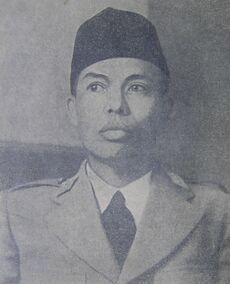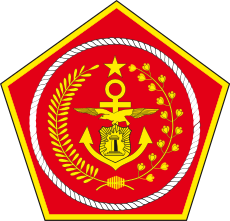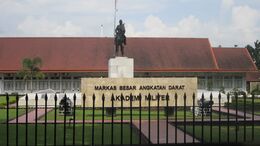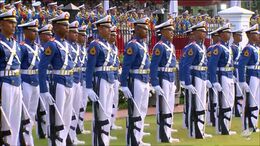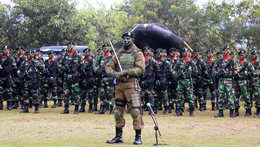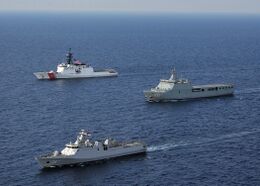القوات المسلحة الوطنية الإندونيسية
| Indonesian National Armed Forces | |
|---|---|
| Tentara Nasional Indonesia | |
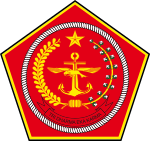 Insignia of the Indonesian National Armed Forces | |
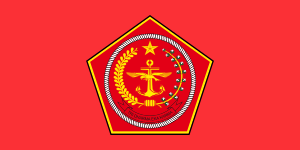 Flag of the Indonesian National Armed Forces | |
| الشعار | بالسنسكريتية: Tri Dharma Eka Karma تر. 'Three services, one determination' |
| تأسس | 5 أكتوبر 1945 as the Tentara Keamanan Rakyat ('People's Security Forces') |
| الصيغة الحالية | 3 يونيو 1947 |
| فروع الخدمة | |
| المقر الرئيسي | Cilangkap, Jakarta |
| الموقع الإلكتروني | tni |
| القيادة | |
| Commander-in-Chief | President Joko Widodo |
| Minister of Defence | Lt. Gen. (ret.) Prabowo Subianto |
| Commander of the Armed Forces | ACM Hadi Tjahjanto |
| العديد | |
| سن التجنيد | 18 |
| المتاحون للخدمة العسكرية | 131,000,000, age 15–49 (131,000,000[3]) |
| اللائقون للخدمة العسكرية | 108,000,000, age 15–49 (131,000,000[3]) |
| عدد البالغين سن التجنيد سنوياً | 4,500,000 (131,000,000[3]) |
| الأفراد النشطون | 400,000[1] (13th ذوي الرتب) |
| أفراد الاحتياط | 400,000[1] |
| الأفراد المنشورون | 3,544[2] |
| النفقات | |
| الميزانية | US$9٫2 billion (2021) |
| النسبة من ن.م.ا. | 0.7% (2018)[4] |
| الصناعة | |
| الموردون المحليون | List
|
| الموردون الأجانب | |
| مقالات ذات صلة | |
| التاريخ | Military history of Indonesia
List of engagements
United Nations Peacekeeping Indonesian National Revolution Darul Islam (Indonesia) Republic of South Maluku PRRI Permesta Incorporation of West Papua into Indonesia Operation Trikora Indonesia–Malaysia confrontation Indonesian invasion of East Timor Insurgency in Aceh Free Papua Movement 2003–2004 Indonesian offensive in Aceh Operation Tinombala |
| الرتب | See Indonesian military ranks |
The Indonesian National Armed Forces (إندونيسية: Tentara Nasional Indonesia, literally "Indonesian National Military"; abbreviated as TNI) are the military forces of the Republic of Indonesia. It consists of the Army (TNI-AD), Navy (TNI-AL), and Air Force (TNI-AU). The President of Indonesia is the commander-in-chief of the Armed Forces. In 2016, it comprises approximately 395,500[7] military personnel including the Indonesian Marine Corps (Korps Marinir RI), which is a branch of the Navy.
Initially formed with the name of the People's Security Army (TKR), then later changed to the Republic of Indonesia Army (TRI) before changing again its name to the Indonesian National Armed Forces (TNI) to the present. The Indonesian Armed Forces were formed during the Indonesian National Revolution, when it undertook a guerrilla war along with informal militia. As a result of this, and the need to maintain internal security, the Armed forces including the Army, Navy, and Air Force has been organised along territorial lines, aimed at defeating internal enemies of the state and potential external invaders.[8]
Under the 1945 Constitution, all citizens are legally entitled and obliged to defend the nation. Conscription is provided for by law, yet the Forces have been able to maintain mandated strength levels without resorting to a draft. Most enlisted personnel are recruited in their own home regions and generally train and serve most of their time in units nearby.
The Indonesian armed forces (military) personnel does not include members of law enforcement and paramilitary personnel such as the Indonesian National Police (Polri) consisting of approximately 590,000+ personnel, Mobile Brigade Corps (Brimob) of around 42,000+ armed personnel, and the Indonesian College Students' Regiment or Resimen Mahasiswa (Menwa) which is a collegiate military service consisting 26,000 trained personnel.
التاريخ
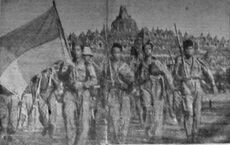
الخطط المستقبلية
تاريخ التسمية
- People's Security Bureau (Badan Keamanan Rakyat, 22 August – 5 October 1945; spelled "Ra'jat")
- People's Security Forces (Tentara Keamanan Rakyat, 5 October 1945 – 7 January 1946; spelled "Ra'jat")
- People's Safety Forces (Tentara Keselamatan Rakyat, 7–26 January 1946; spelled "Ra'jat")
- Republic of Indonesia Armed Forces (Tentara Republik Indonesia, 26 January 1946 – 3 June 1947; spelled "Repoeblik" until 17 March 1947)
- Indonesian National Armed Forces (Tentara Nasional Indonesia, 3 June 1947 – 27 December 1949)
- Republic of the United States of Indonesia War Forces (Angkatan Perang Republik Indonesia Serikat, 27 December 1949 – 17 August 1950)
- Republic of Indonesia War Forces (Angkatan Perang Republik Indonesia, 17 August 1950 – 21 June 1962)
- Republic of Indonesia Armed Forces (Angkatan Bersenjata Republik Indonesia, 21 June 1962 – 1 April 1999; spelled "Bersendjata" until 1 January 1973)
- Indonesian National Armed Forces (Tentara Nasional Indonesia, since 1 April 1999) *the name TNI was still used during ABRI era when it came to the military itself and the branches excluding the Police (e.g. TNI-AD/AL/AU). But when it was Armed Forces as a whole including the Police the term ABRI was used instead.
الفلسفة والعقيدة
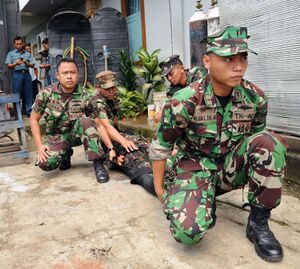
التنظيم
عناصر القيادة
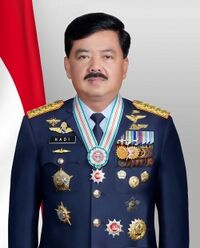
عناصر القيادة المساعدة
- Chief of the General Staff of the TNI (Kasum TNI). Office currently held by: Lieutenant General Ganip Warsito.
- Inspector General of the TNI (Irjen TNI). Office currently held by: Lieutenant General (Marine Corps) Bambang Suswantono.
- TNI Expert Advisor (Korsahli Panglima TNI). Office currently held by: Major General Sisriadi.
- TNI Advisor for Strategic Policy and General Planning (Asrenum Panglima TNI). Office currently held by: Rear Admiral Heru Kusmanto.
- TNI Intelligence Advisor (Asintel Panglima TNI). Office currently held by: Major General Andjar Wiratma.
- TNI Operations Advisor (Asops Panglima TNI). Office currently held by: Major General Tiopan Aritonang.
- TNI Personnel Advisor (Aspers Panglima TNI). Office currently held by: Air Vice Marshal Diyah Yudanardi.
- TNI Logistics Advisor (Aslog Panglima TNI). Office currently held by: Air Vice Marshal Dento Priyono.
- TNI Territorial Advisor (Aster Panglima TNI). Office currently held by: Major General Madsuni.
- TNI Communications and Electronics Advisor (Askomlek Panglima TNI). Office currently held by: Rear Admiral Lutfi Syaefullah.
عناصر الخدمة
- Military Psychology Center (Pusat Psikologi TNI)
- Communications and Electronics Unit (Satuan Komunikasi dan Elektronika TNI)
- Operational Control Center (Pusat Pengendalian Operasi TNI)
- Bureaucratic Reform Center (Pusat Reformasi Birokrasi TNI)
- Office of the Secretariat General (Sekretariat Umum TNI)
- GHQ Detachment (Detasemen Markas Besar TNI)
الوكالات التنفيذية المركزية
- Staff and Command Colleges (Sekolah Staf [ك] dan Komando TNI/ Sesko TNI)
- Army Command and General Staff College
- Naval Command and Staff College
- Air Force Command and Staff College
- Armed Forces Academy (Akademi TNI)
- Military Academy Magelang
- Naval Academy Surabaya
- Air Force Academy Yogyakarta
- Strategic Intelligence Agency (Badan Intelijen Strategis TNI/ Bais TNI)
- Education, Training and Doctrine Development Command (Komando Pembinaan Doktrin dan Latihan TNI/ Kodiklat TNI)
- Special Operations Command (Komando Operasi Khusus/ Koopsus TNI)
- Presidential Security Forces (Pasukan Pengamanan Presiden/ Paspampres)
- Legal Service and General Counsel Agency (Badan Pembinaan Hukum/ Babinkum TNI)
- Public Relations Center (Pusat Penerangan TNI)
- Health Center (Pusat Kesehatan TNI)
- Military Police Center (Pusat Polisi Militer/ Puspom TNI)
- Finance Center (Pusat Keuangan TNI)
- Peacekeeping Maintenance Missions Center (Pusat Misi Pemeliharaan Perdamaian TNI)
- Strategic Assessment and R&D Center ( Pusat Pengkajian Strategis, Penelitian, dan Pengembangan TNI)
- Logistics Agency (Badan Perbekalan/ Babek TNI)
- Chaplaincy Center (Pusat Pembinaan Mental/ Pusbintal TNI)
- Military Historical Center (Pusat Sejarah TNI)
- Information and Communications Technologies and Data Processing Center (Pusat Informasi dan Pengolahan Data/ Pusinfolahta TNI)
- International Cooperation Center (Pusat Kerjasama Internasional TNI)
- Physical Fitness and Military Regulations Center (Pusat Jasmani dan Peraturan Militer Dasar TNI)
- Procurement Center (Pusat Pengadaan TNI)
- Maritime Information Center (Pusat Informasi Maritim)
- General Headquarters Garrison (Komando Garnisun Tetap)
- Cyber Operations Unit (Satuan Siber TNI)
القيادة العملياتية الرئيسية
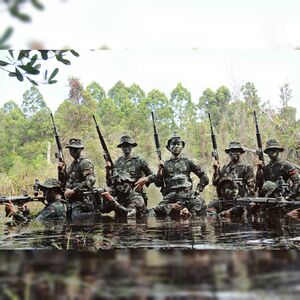
Principal Operation Commands (Komando Utama Operasi) are the centralized TNI forces which are under the command of Panglima TNI.
| Num | Command | Commander(s) |
|---|---|---|
| 1 | Defense Joint Service Regional Command (Komando Gabungan Wilayah Pertahanan/ Kogabwilhan) | Vice Admiral I Nyoman Gede Ariawan (1st Region); Air Marshal Imran Baidirus (2nd Region); Lieutenant General Agus Rohman (3rd Region) |
| 2 | Army Strategic Command (Komando Strategis Angkatan Darat) | Lieutenant General Eko Margiyono |
| 3 | Fleet Forces Commands (Komando Armada) | Rear Admiral Abdul Rasyid Kacong (1st Fleet); Read Admiral I Nyoman Gede Sudihartawan (2nd Fleet); Read Admiral Dadi Hartanto (3rd Fleet) |
| 4 | National Air Operations Commands (Komando Operasi Udara Nasional) | Air Marshal Tri Bowo Budi Santoso (1st Ops); Air Marshal Minggit Tribowo (2nd Ops); Air Marshal Novyan Samyoga (3rd Ops) |
| 5 | Naval Hydro-Oceanographic Center (Pusat Hidro-Oseanografi) | Rear Admiral Agung Prasetiawan |
| 6 | Regional Military Commands (Komando Daerah Militer) | total 15 regions, each is commanded by two-star army general |
| 7 | Special Forces Command (Komando Pasukan Khusus) | Major General Mohammad Hasan |
| 8 | Military Sealift Command (Komando Lintas Laut Militer) | Rear Admiral Irvansyah |
| 9 | Specialized Forces Corps (Paskhas / Pasgat) | Air Marshal Eris Widodo |
| 10 | Indonesian Marine Corps (Korps Marinir) | Major General (Marine Corps) Suhartono |
الفروع
وحدة القوات الخاصة
- TNI AD
 (Indonesian Army): Kopassus
(Indonesian Army): Kopassus - TNI AL
 (Indonesian Navy) & Indonesian Marine Corps : Taifib, Denjaka
(Indonesian Navy) & Indonesian Marine Corps : Taifib, Denjaka - TNI AU
 (Indonesian Air Force): Paskhas
(Indonesian Air Force): Paskhas
قوات الاحتياط
الميزانية
In addition, the territorial commands (KODAM) are responsible for 'the bulk of their operational fund-raising.'[9]
| Fiscal Year | Budget (IDR) | Budget (USD) |
|---|---|---|
| 2005 | Rp 21.97 trillion | USD 2.5 billion |
| 2006 | Rp 23.6 trillion | USD 2.6 billion |
| 2007 | Rp 32.6 trillion | USD 3.4 billion |
| 2008 | Rp 36.39 trillion | USD 3.8 billion |
| 2009 | Rp 33.6 trillion | USD 3.3 billion |
| 2010 | Rp 42.3 trillion | USD 4.47 billion |
| 2011 | Rp 47.5 trillion | USD 5.2 billion |
| 2012 | Rp 64.4 trillion[10] | USD 7.5 billion |
| 2013 | Rp 81.8 trillion[11] | USD 8.44 billion[citation needed] |
| 2014 | Rp 83.4 trillion[citation needed] | USD 7.91 billion[12] |
| 2015 | Rp 95.5 trillion[13] | USD 8.05 billion |
| 2016 | Rp 99.5 trillion[14] | USD 7.3 billion |
| 2017 | Rp 109.3 trillion[15] | USD 8.17 billion |
| 2018 | Rp 108. trillion[16] | USD 8. billion |
| 2019 | Rp 121 trillion[17] | USD 9.1 billion |
| 2020 | Rp 131 trillion[17] | USD 9.35 billion |
| *2020 (Budget cuts) | Rp 122 trillion[18] | USD 8.67 billion |
| 2021 | Rp 136 trillion | USD 9.2 billion |
*The 2020 budget was changed due to COVID-19 outbreak, while the budget for the Ministry of Health, and Ministry of Education and Culture has been increased.[18]
القادة
الزي الرسمي
Indonesian armed forces uniforms are categorized into three types:
- PDH: Pakaian Dinas Harian (Service Uniform)
- TNI AD: green shirt, with dark green trousers
- TNI AL: greyish blue shirt, with dark greyish trousers. white shirt with white trousers (for international duties)
- TNI AU: light blue shirt, dark blue trousers
- PDL: Pakaian Dinas Lapangan (Battle / Combat / Field Uniform)
- TNI AD: mostly green cammouflage
- TNI AL: mostly grey cammouflage (except for the marine corps personnel who wear green cammouflage)
- TNI AU: mostly blue camouflage (except for the Pasgat personnel who wear green cammouflage)
- PDU: Pakaian Dinas Upacara (Ceremony / Dress Uniform)
- TNI AD: dark green suit
- TNI AL: white suit. black suit (for international duties).
- TNI AU: light blue coat, dark blue trousers.
الأفراد
الرتب العسكرية
Armed Forces Pledge (Sapta Marga)
The Armed Forces Pledge is a pledge of loyalty and fidelity of the military personnel to the government and people of Indonesia and to the principles of nationhood.
| Original Indonesian | English |
|---|---|
| 1. Kami Warga Negara Kesatuan Republik Indonesia yang bersendikan Pancasila. | We, solemn citizens of the Republic of Indonesia, truthfully believe in Pancasila. |
| 2. Kami Patriot Indonesia, pendukung serta pembela Ideologi Negara yang bertanggung jawab dan tidak mengenal menyerah. | We, patriots of Indonesia, are the forthright supporter and defender of the nation's ideology and shall admit to refuse surrender. |
| 3. Kami Kesatria Indonesia, yang bertaqwa kepada Tuhan Yang Maha Esa, serta membela kejujuran, kebenaran dan keadilan. | We, humble guardians of Indonesia, who believe in the One True God, are ever-committed to uphold honesty, truth and justice. |
| 4. Kami Prajurit Tentara Nasional Indonesia, adalah Bhayangkari Negara dan Bangsa Indonesia. | We, (the servicemen and women) of the Indonesian National Armed Forces, hereby (swear the oath to forever) serve as the champion of the Indonesian nation and its people. |
| 5. Kami Prajurit Tentara Nasional Indonesia, memegang teguh disiplin, patuh dan taat kepada pimpinan serta menjunjung tinggi sikap dan kehormatan prajurit. | We, (the servicemen and women) of the Indonesian National Armed Forces, strive to uphold military discipline, loyalty to the chain of command and promote the honor and conduct of becoming (military) service personnel. |
| 6. Kami Prajurit Tentara Nasional Indonesia, mengutamakan keperwiraan di dalam melaksanakan tugas, serta senantiasa siap sedia berbakti kepada Negara dan Bangsa. | We, (the servicemen and women) of the Indonesian National Armed Forces, will ever exemplify the values of honor in carrying out our duties, and readily answer to the call of the nation at any time of need. |
| 7. Kami Prajurit Tentara Nasional Indonesia, setia dan menepati janji serta Sumpah Prajurit. | And we, (the servicemen and women) of the Indonesian National Armed Forces, will be faithful, loyal and true to our our Oath of Duty (Enlistment/Commissioning). |
انظر أيضاً
- العلاقات الخارجية لإندونيسيا
- مسيرة القوات المسلحة الوطنية الإندونيسية
- قائمة طائرات القوات المسلحة الوطنية الإندونيسية
- الجيش الإندونيسي
- البحرية الإندونيسية
- القوات الجوية الإندونيسية
- وكالة الأمن البحري الإندونيسي
- حرس البحر والسواحل الإندونيسي
- وزارة الدفاع الإندونيسية
الهوامش
المصادر
- ^ أ ب IISS 2018, pp. 266-267
- ^ "Indonesia and the United Nations Peacekeeping Mission". kemlu.go.id. Ministry of Foreign Affairs of the Republic of Indonesia. 29 January 2019. Retrieved 7 January 2020.
- ^ "Indikator Pembangungan Dunia-Penjelajah Google Data Publik". google.co.id. Archived from the original on 20 December 2016. Retrieved 10 December 2016.
- ^ "Military expenditure by country, in constant (2017) US$ m., 1988–2018" (PDF). Stockholm International Peace Research Institute. 2019. Archived (PDF) from the original on 11 July 2019. Retrieved 2 July 2019.
- ^ "PT Palindo Marine Shipyard". palindomarine.com. Archived from the original on 30 أبريل 2015. Retrieved 27 أكتوبر 2015.
- ^ "CMI Teknologi Official Website". cmiteknologi.com. Archived from the original on 29 July 2017. Retrieved 27 October 2015.
- ^ International Institute for Strategic Studies (3 February 2014). The Military Balance 2014. London: Routledge. pp. 246–250. ISBN 978-1-85743-722-5.
- ^ "Archived copy". Archived from the original on 3 January 2007. Retrieved 12 June 2011.
{{cite web}}: CS1 maint: archived copy as title (link) - ^ Beeson and Bellamy, 2008, 138.
- ^ "Archived copy". Archived from the original on 5 October 2011. Retrieved 20 August 2011.
{{cite web}}: CS1 maint: archived copy as title (link) - ^ "While education and healthcare suffer, Indonesian army budget soars". 18 July 2012. Archived from the original on 2012-08-01.
{{cite web}}: CS1 maint: unfit URL (link) - ^ "Janes | Latest defence and security news". Janes.com. Archived from the original on 4 June 2020. Retrieved 30 June 2020.
- ^ "SBY maintains status quo in 2015 budget". 18 August 2014. Archived from the original on 7 September 2014. Retrieved 7 September 2014.
- ^ "Kementerian PU Dapat Anggaran Terbanyak dari APBN 2016". finansial.bisnis.com. Archived from the original on 6 November 2015. Retrieved 3 November 2015.
- ^ "Revised Indonesian budget brings modest increase – Jane's 360". janes.com. Archived from the original on 14 July 2017. Retrieved 22 July 2017.
- ^ Aziza, Kurnia Sari (26 October 2017). "Kemenhan dan Polri Dapat Anggaran Paling Besar pada APBN 2018". Kompas (in الإندونيسية). Archived from the original on 11 January 2018. Retrieved 10 January 2018.
- ^ أ ب Prasetia, Andhika (5 October 2019). "Jokowi: Anggaran Pertahanan Dinaikkan Lebih Dari Rp 131 Triliun di 2020". detik. Archived from the original on 27 March 2020. Retrieved 27 March 2020.
- ^ أ ب Liputan6.com (2020-04-13). "Anggaran Kemhan-KPK Dipangkas untuk Corona, Kemdikbud dan Kemkes Ditambah". liputan6.com (in الإندونيسية). Retrieved 2020-10-11.
{{cite web}}: CS1 maint: numeric names: authors list (link)
قراءات إضافية
- International Institute for Strategic Studies (14 February 2018). The Military Balance 2018. London: Routledge. ISBN 978-1-85743-955-7.
- Bresnan, John. (1993). Managing Indonesia: the modern political economy. New York: Columbia University Press.
- Many topics, including the political role of the military at the height of Suharto's New Order.
- Chandra, Siddharth and Douglas Kammen. (2002). "Generating Reforms and Reforming Generations: Military Politics in Indonesia's Transition to Democracy." World Politics, Vol. 55, No. 1.
- Crouch, Harold. (1988). The army and politics in Indonesia. Ithaca:Cornell University Press.
- First published 1978. Now somewhat dated, but provides an influential overview of the role of the military in consolidating Suharto's power
- "Guerilla Warfare and the Indonesian Strategic Psyche" Small Wars Journal article by Emmet McElhatton
- Israel, Fauzi.(2009) – Advanced Weapon's Infantry Firepower & Accuracy
- Kammen, Douglas and Siddharth Chandra. (1999). A Tour of Duty: Changing Patterns of Military Politics in Indonesia in the 1990s. Ithaca, New York: Cornell Modern Indonesia Project No. 75.
- Kingsbury, Damen. Power Politics and the Indonesian Military, Routledge: 2003 ISBN 0-415-29729-X
وصلات خارجية
- CS1 maint: unfit URL
- CS1 الإندونيسية-language sources (id)
- CS1 maint: numeric names: authors list
- Articles containing سنسكريتية-language text
- Articles containing إندونيسية-language text
- Pages using Lang-xx templates
- Articles with hatnote templates targeting a nonexistent page
- Articles with unsourced statements from April 2020
- Pages with empty portal template
- عسكرية إندونيسيا
- التاريخ العسكري لإندونيسيا
- وحدات وتشكيلات عسكرية تأسست في 1945
- تأسيسات 1945 في إندونيسيا
